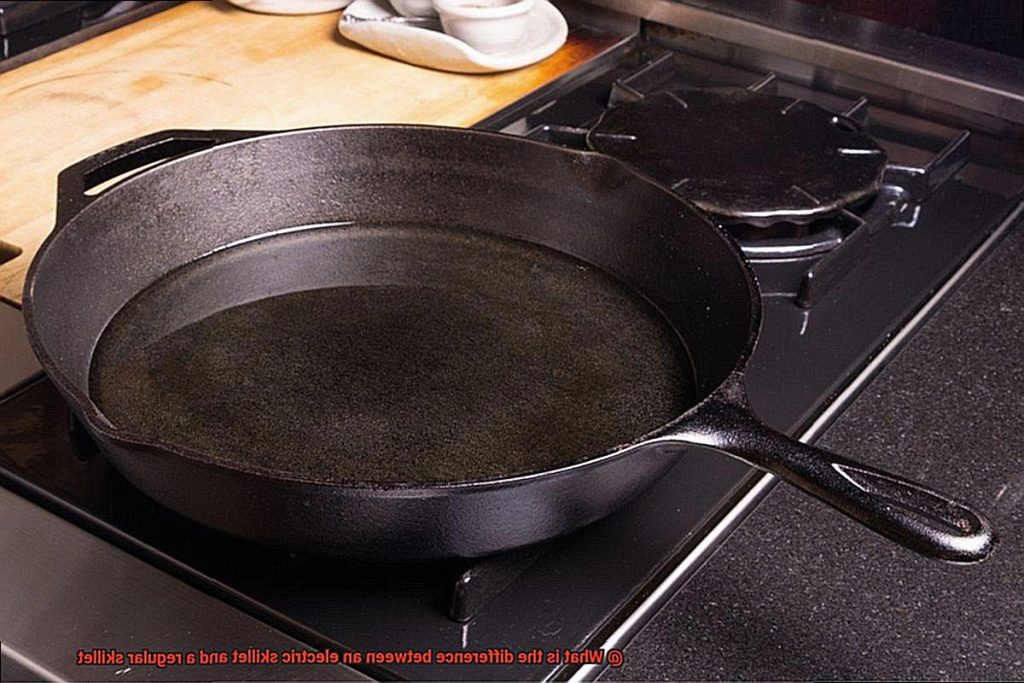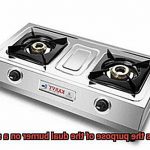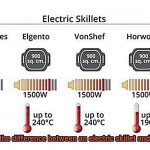Do you consider yourself a culinary adventurer, always on the lookout for new kitchen gadgets to try out? If so, you may have stumbled upon two types of skillets: electric and regular. But do you know what sets them apart? Fear not, my friend. In this blog post, we’ll take a closer look at these two kitchen staples and help you understand their differences.
At first glance, electric skillets and regular skillets may seem like peas in a pod. However, there are some key differences that can affect your cooking experience. For starters, an electric skillet is an independent appliance that plugs into an electrical outlet and heats up using electricity. On the other hand, a regular skillet is typically made of metal or cast iron and used on a stovetop to cook food.
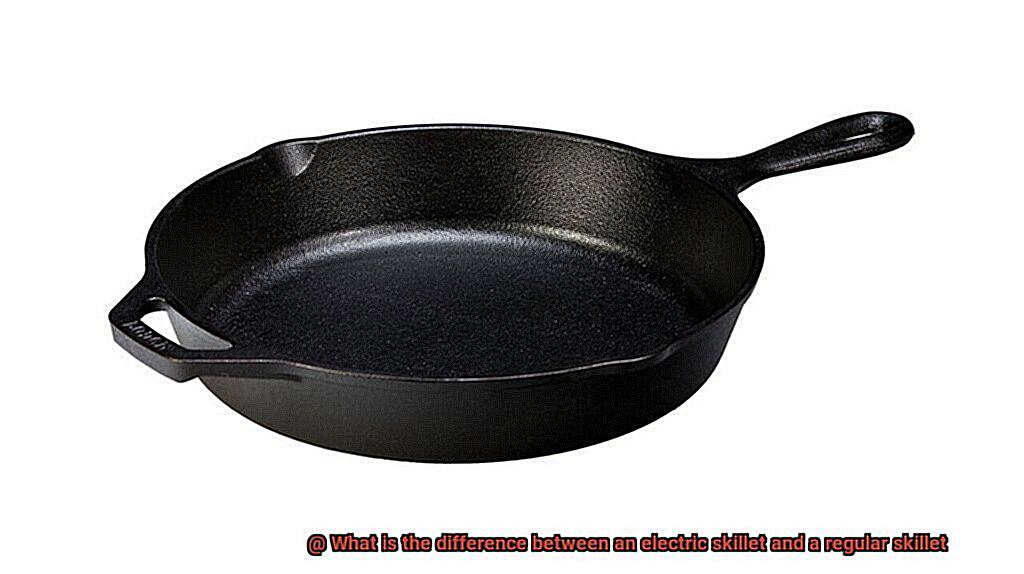
One major advantage of using an electric skillet is its precise temperature control feature that allows you to adjust the heat according to your recipe’s requirements. Moreover, most electric skillets come with non-stick surfaces that cut down on oil usage for healthier meals.
In contrast, regular skillets offer versatility as they can be used on different stove types such as gas, electric or induction. Additionally, they provide a more traditional cooking experience where you have complete control over the heat distribution.
Exciting stuff. Keep reading to find out more about the differences between these two types of skillets and which one suits your culinary style best.
Contents
What is a Regular Skillet?
If you’re a home cook, then you know the importance of having a regular skillet in your kitchen. This versatile tool is also known as a frying pan and is used for a variety of cooking tasks, from searing steaks to sautéing vegetables. So, what exactly is a regular skillet and why is it so essential?
A regular skillet typically has a flat bottom with slightly sloping sides that gradually curve upwards. It is made of metal and can range in size from small to large, depending on your specific needs. The most common materials used to make skillets are stainless steel, cast iron, and nonstick coatings.
Stainless steel skillets are durable and easy to clean but tend to be less effective at distributing heat evenly. Cast iron skillets are heavy and take longer to heat up but are excellent at retaining heat and can be used on any heat source. Nonstick skillets are coated with a material that prevents food from sticking to the surface, making them ideal for cooking delicate foods or recipes that require minimal oil.
Regular skillets are designed to be used on stove tops or open flames and require some amount of oil or butter to prevent food from sticking. They can be used for high-heat cooking, such as searing steaks or frying chicken, but they can also be used for lower heat tasks like sautéing vegetables or making omelets.
One of the advantages of using a regular skillet over an electric skillet is the control it provides over the temperature. With a regular skillet, you can adjust the heat source as needed throughout the cooking process for optimal results. Additionally, regular skillets can be used anywhere there’s a heat source available – making them great for outdoor cooking or camping trips.
In terms of size and shape, regular skillets come in various options to fit different cooking needs and preferences. Whether you’re cooking for one or feeding a large group, there’s a skillet size that’s perfect for you.
What is an Electric Skillet?
If you’re looking for a convenient and versatile kitchen appliance that can help you cook a wide range of meals with ease, then an electric skillet should be at the top of your shopping list. An electric skillet is similar to a regular frying pan or skillet, but with an electrical heating element built into the base that allows for precise temperature control.
The non-stick materials used to make most electric skillets make cleanup a breeze, while also reducing the amount of oil or butter needed for cooking. The high sides of the skillet also make it ideal for cooking dishes that require liquids or sauces such as stews, soups, or casseroles.
But what really sets an electric skillet apart from other kitchen appliances is its portability. Since it only requires an electrical outlet, you can take it anywhere you go. This makes it perfect for outdoor cooking or for use in RVs or other small living spaces where a stove may not be available.
Materials Used for Regular and Electric Skillets
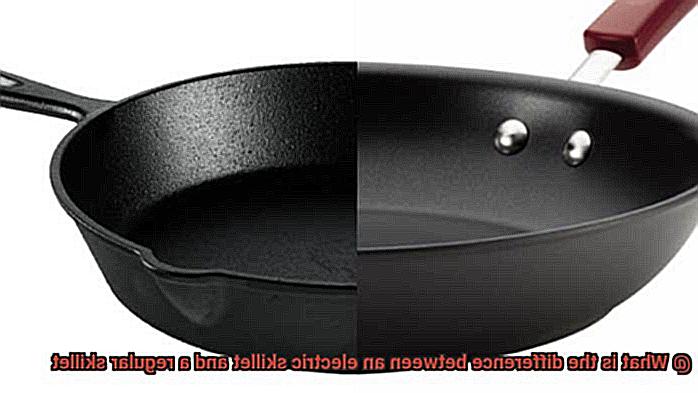
When it comes to regular skillets, the most common materials used are stainless steel, cast iron, and copper. These materials are known for their durability, heat retention, and even heating. They are perfect for various cooking techniques and can last a long time with proper care. Plus, they provide delicious sears and crisp crusts that are hard to beat.
On the other hand, electric skillets are designed for convenience and ease of use. They’re often made with non-stick surfaces such as Teflon or ceramic coatings, which make cooking and cleanup a breeze. Some electric skillets are also made with lightweight materials like aluminum, making them portable and easy to handle.
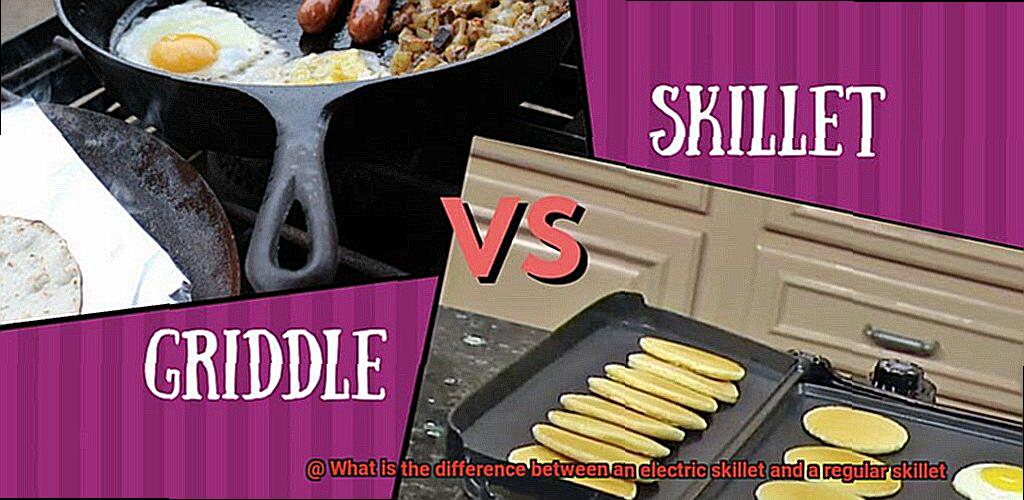
One critical difference between regular and electric skillets is their construction. Traditional skillets usually have a solid base that allows for direct contact with the heat source. In contrast, electric skillets have a built-in heating element in their base that heats up the cooking surface. This construction design provides more control over the temperature of the pan.
When choosing between these two types of skillets, it ultimately depends on your needs and preferences. If you prefer versatility and even heating, then a regular skillet might be the way to go. But if you’re all about convenience and easy cleanup, then an electric skillet might be your new best friend. Here are some key takeaways to consider:
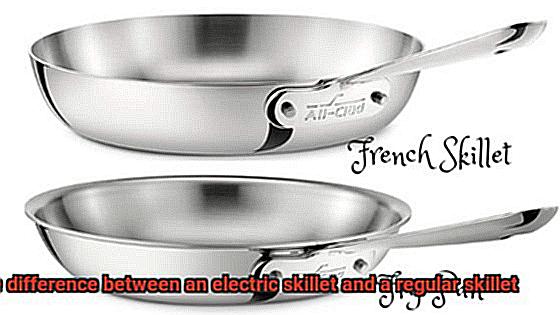
-
- Regular skillets: Choose a material that suits your cooking needs (e.g., stainless steel for searing meats or cast iron for cooking stews). They’re perfect for those who want versatile cookware that can handle high temperatures and last a long time.
- Electric skillets: Consider the size and shape of the skillet, as well as the material of the non-stick coating. They’re perfect for those who want an easy-to-use, easy-to-clean skillet that heats up quickly and provides consistent heat.
Heating Sources for Regular and Electric Skillets
The heating source used can greatly impact the quality of your cooking, so it’s essential to consider the pros and cons of each option.
Regular skillets, also known as traditional skillets, are heated on a stovetop using gas or electric burners. With this method of heating, you have full control over adjusting the heat manually to attain the desired temperature. However, this can be challenging for beginners or those who are not accustomed to stovetop cooking. Additionally, regular skillets may have hotspots that can lead to uneven cooking.
Electric skillets, on the other hand, have a heating element embedded in their base that provides consistent and even heat across the entire surface of the skillet. This eliminates hotspots and ensures even cooking throughout your meal. Electric skillets often come with temperature controls that make it easy to adjust the heat according to your desired settings, making them an excellent option for beginners or those who want easy-to-control heat.
One of the main advantages of electric skillets is that they offer more consistent and even heat than regular skillets. This is because the electric heating element ensures that the entire surface of the skillet heats up evenly, eliminating hotspots that can cause uneven cooking. Additionally, electric skillets often come with temperature controls that allow you to easily adjust the heat to your desired setting.
However, one downside to electric skillets is that they may not provide enough heat for certain recipes that require high temperatures. Furthermore, some people may find them less versatile than regular skillets because they do not work on gas stovetops.
Cooking Surface Comparison between Regular and Electric Skillets
Choosing between a traditional regular skillet and an electric one can be a difficult decision, especially when it comes to the cooking surface. Here’s a breakdown of the key differences between the two.
Regular skillets are typically made from cast iron, stainless steel, or aluminum, with a flat bottom that makes them suitable for use on various heat sources such as gas, electric, and induction stovetops. These skillets have either an uncoated or non-stick coated cooking surface to prevent food from sticking.
In contrast, electric skillets have a non-stick cooking surface made of materials such as ceramic or Teflon. The surface is heated by an electric heating element that is embedded beneath it. Electric skillets are designed to be used independently of a stove-top and come with temperature controls that allow for precise heat adjustments.
The most significant advantage of an electric skillet over a regular skillet is its even heating capabilities. An electric skillet heats up evenly across the entire cooking surface, ensuring that food cooks evenly without hot spots. This feature makes it ideal for preparing delicate foods that require gentle and even heat such as pancakes, eggs, and fish.
On the other hand, regular skillets have hot spots that can cause food to burn or cook unevenly if not handled correctly. Additionally, an electric skillet can be used for slow cooking, simmering, and keeping food warm for extended periods of time without drying out or burning.
When it comes to size, regular skillets come in various sizes ranging from small to large depending on the intended use. They are also stackable and take up less storage space compared to their electric counterparts. However, electric skillets are typically larger and bulkier due to the presence of the heating element and temperature controls.
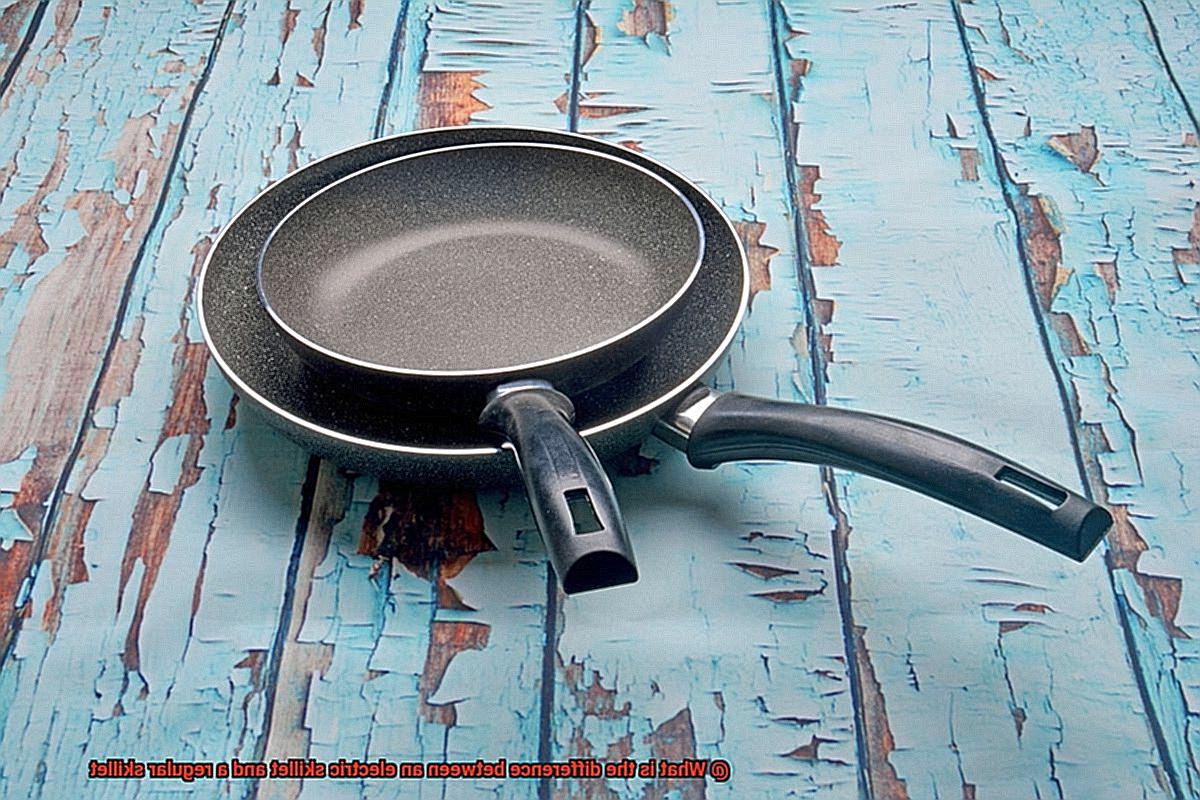
Temperature Control Settings on Electric Skillets
Unlike regular skillets, electric skillets come with a built-in temperature control feature that allows you to set the desired temperature for cooking. This feature is crucial when cooking delicate dishes that require precise temperature control. With an electric skillet, you can effortlessly maintain a consistent temperature without any guesswork.
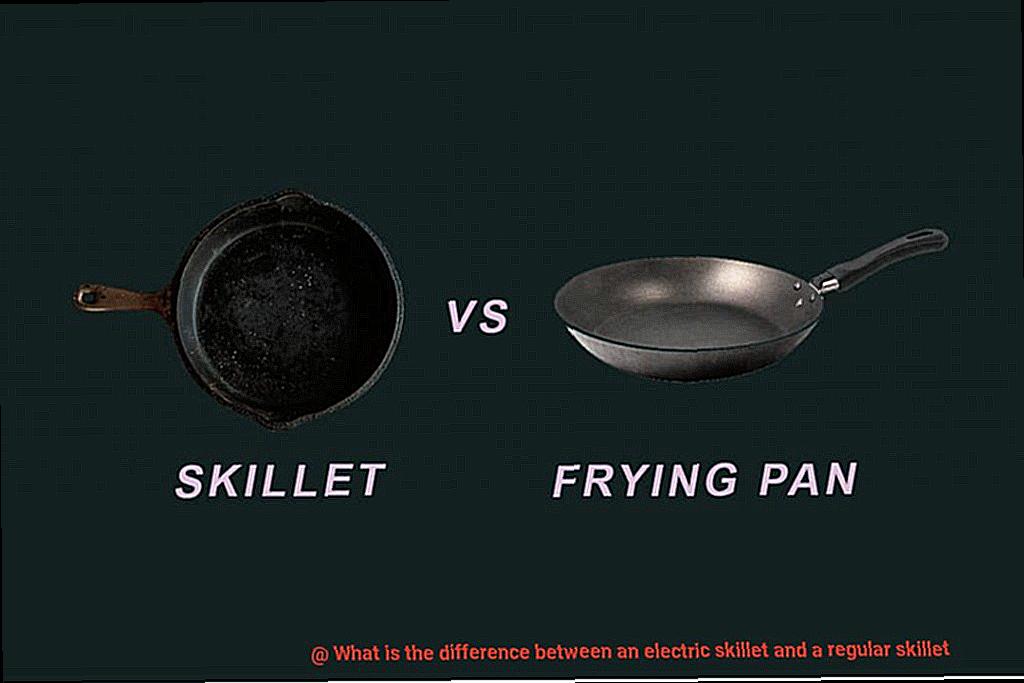
Most electric skillets offer a wide range of adjustable temperature settings, usually ranging from 200°F to 400°F or even higher. You can easily adjust the temperature by using the dial or digital display on the skillet. This feature allows you to cook a wide variety of dishes at different temperatures, from searing steaks to simmering sauces.
In addition to adjustable temperature settings, some electric skillets come with specific temperature settings for different types of cooking methods. For instance, frying, grilling, sautéing, and baking each have their specific temperature requirements. With these options, you can use one appliance for multiple cooking methods, saving time and effort in the kitchen.
Using a regular skillet requires manual adjustment of the heat source which could lead to inconsistency in maintaining a constant temperature. Cooking with an electric skillet eliminates this issue, allowing you to focus on creating delicious meals without worrying about overcooking or undercooking your dish.
Benefits of Using a Regular Skillet
If you’re a fan of home-cooked meals or looking for a reliable cooking companion, then this is the article for you. Regular skillets have been around for centuries and have proven to be an essential tool in any kitchen. Let’s dive into the fantastic benefits of using a regular skillet and why it’s an ideal choice for all your cooking needs.
One of the most significant benefits of using a regular skillet is its even heat distribution. Unlike electric skillets that may heat up unevenly, a regular skillet distributes heat evenly across its surface. This means that your food is less likely to burn or cook unevenly, which results in better-tasting dishes. Whether you’re frying up some eggs or searing a steak, you can trust that your regular skillet will provide consistent heat throughout the cooking process.
Another great benefit of using a regular skillet is its versatility. You can use it for a variety of cooking methods such as frying, searing, sautéing, and even baking. It’s perfect for making one-pan meals like frittatas and stir-fries. You can also move it from stovetop to oven for recipes that require both cooking methods. With a regular skillet, you have endless possibilities when it comes to meal preparation.
Durability is another advantage of using a regular skillet. A well-made skillet can last for years with proper care and maintenance. Cast iron skillets, in particular, are known for their durability and can be passed down through generations as family heirlooms. Invest in a high-quality regular skillet, and it will serve you well for years to come.
Finally, let’s talk about cost-effectiveness. A regular skillet is an affordable kitchen tool that can be found at most stores. It doesn’t require electricity to use, making it a cost-effective option compared to electric skillets. You also don’t need to worry about replacing any parts or dealing with complicated settings. A regular skillet is a straightforward and reliable tool that will simplify your cooking experience.
Benefits of Using an Electric Skillet
As an expert on the benefits of using this versatile kitchen appliance, I’m thrilled to share with you all the ways it can revolutionize your cooking experience.
One of the biggest advantages of an electric skillet is its ability to maintain precise temperature control. Thanks to its built-in thermostat, you can set the temperature to the exact degree your recipe calls for, ensuring even cooking and delicious results. Unlike traditional skillets, which rely on the heat from a stove, an electric skillet guarantees that your food is cooked evenly and at the desired temperature.
Electric skillets are also incredibly portable, allowing you to cook anywhere there’s an electrical outlet. Whether you’re on a camping trip, hosting a picnic, or simply want to cook outside, an electric skillet is the perfect solution. Say goodbye to worrying about finding a stove or oven when you’re out and about.
Cleaning up after cooking can be a hassle, but with an electric skillet, it’s a breeze. Many models come with a non-stick surface, which means food won’t stick to the bottom of the pan. Additionally, electric skillets are made from durable materials like stainless steel or aluminum, which makes them resistant to scratches and dents. With proper care, your electric skillet can last for many years.
Finally, electric skillets are a fantastic way to save time in the kitchen. They heat up quickly and evenly, allowing you to cook your food faster than with a traditional skillet. Plus, many models come equipped with features like a timer or automatic shut-off so that you can set it and forget it while your food cooks.
guNMdUpTVHo” >
Conclusion
In summary, the difference between an electric skillet and a regular skillet goes beyond their heating sources. While regular skillets are typically made of metal or cast iron and used on stovetops, electric skillets are independent appliances that plug into electrical outlets for heating.
Electric skillets offer precise temperature control and non-stick surfaces that reduce oil usage, making them ideal for healthier meals. Their portability and easy-to-clean features also make them perfect for outdoor cooking or small living spaces where stoves may not be available.
On the other hand, regular skillets provide versatility as they can be used on different stove types such as gas, electric or induction. They offer a traditional cooking experience with complete control over heat distribution and come in various sizes to fit different cooking needs.
Ultimately, selecting between an electric skillet and a regular skillet depends on your specific needs and preferences. If you value versatility and even heating, then a regular skillet might be your best bet. However, if convenience and easy cleanup with precise temperature control features matter more to you, then an electric skillet could be your new go-to tool.

